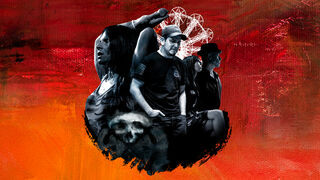Health
"Sound of Scars" Reveals Emotional Power of Life of Agony
Documentary examines musical and mental health journey of heavy metal band.
Posted May 7, 2021 Reviewed by Devon Frye
Key points
- Music therapy has been shown in research to improve mental health.
- Extreme heavy metal music, in particular, may help reduce anger and stress while increasing positive emotions, one study suggested.
- The movie "Sound of Scars" details the story of the band Life of Agony's struggle to cope with emotional pain through music.
“I got the razor at my wrist 'cause I can't resist
I've got this fever burnin' fist that does as I wish
But when I get downtown and see what's around
I just know there's got to be a better place to be found”From “River Runs Red” by Life of Agony
If you believe in the power of music to transform and save lives, the movie "Sound of Scars" (2021) is for you.
"Sound of Scars" takes us through the over 30-year history of the heavy metal band Life of Agony and its current members Mina Caputo, Alan Robert, Joseph Zampella (aka Joey Z), and Veronica Bellino. This powerful and compelling movie invites us into Life of Agony's dark, intense and at times terrifying emotional world—beset with addiction, depression, abuse, and suicide. It walks us through the history of not only how Life of Agony turned these horrible experiences into epic musical statements, but also how their music became a vehicle for the individual members of the band to pursue their most authentic and purpose-driven selves.

As I watched the movie, I began to reflect on the first time I met Joey Z. I believe it was 2005, and my band Odd Zero was going to Method of Groove Studios to record our second album, Admire The Liar. When we got in the studio, Joey and I discussed how we were going to record my vocals. And we came up with a very specific process that was invaluable to me as an aspiring artist.
Joey and I would sit and talk about the event, feeling, or issue that was at the core of the song. It felt like a combination of talking with a therapist, coach, and friend. The conversations were both frightening and validating as I shared intimate emotional details of my life with Joey—a complete stranger at the time—and connected to the emotional anchor of each song.
At some point, I’d inevitably feel a surge of emotion—usually rage—start to boil up within me and I would tell him, “I think I got it.” Then I would jump into the booth, I would start singing and we would record the vocal tracks. It felt cathartic, with Joey providing the context so I could evoke intense emotion and then convert that emotion into artistic expression.
My experience working with Joey is likely similar to how many people experience Life of Agony’s music and live performances. Life of Agony’s secret sauce is an implicit agreement with its fans that the deep emotions expressed in the music were an invitation for the audience to explore, process, and express their own intense feelings. And the band’s vulnerability in tackling difficult issues, particularly involving mental health, gave the audience the opportunity to heal whatever emotional wounds they were struggling with. This process was the emotional context for powerful artistic statements such as their opus River Runs Red (1993), which was called one of the greatest heavy metal albums of all time by Rolling Stone.
The power of music to heal—which is so central to Life of Agony’s ethos—has now been well documented through scientific research. Several studies have demonstrated that music therapy can improve mental and physical health. One meta-analytic review of the effects of music therapy on depression found that in 28 studies of 1,810 participants that music therapy was significantly more efficacious than control groups in reducing depression symptoms.
What has been surprising to many is that heavy music genres such as heavy metal and hardcore punk have demonstrated similar healing powers. For example, one study of extreme metal fans found that when listening to heavy metal music participants experienced reduced anger, stress and hostility, and increased positive emotions.
"Sound of Scars" anchors itself in the emotional experiences of the individual band members, and how they were able to transform their own lives through their music. The movie chronicles Mina’s experience as a transgender woman—and heavy metal’s first openly transgender star. She also explains in more depth her departure from the band in 1997, arguably at the height of the band’s fame. It also explores Alan’s struggle with depression, as well as Joey’s tumultuous relationship with his father.
Throughout the movie, we learn about how the members of the band were struggling with their own individual and family issues, and how they connected and disconnected from one another over time as both friends and bandmates. And one of the potent themes that surges through the movie is how the seemingly brutal genres of hardcore punk and heavy metal were crucial in giving the band an opportunity to express their intense emotions.
There’s a little something in this movie for everyone. Fans will find "Sound of Scars" an enlightening experience, helping them further understand why Life of Agony is one of their favorite bands. Metalheads and punk rockers will enjoy the band’s reminiscing about New York City’s hardcore and metal scene and how they found expression in extreme music. Anyone who struggles with mental health, gender identity, or family issues will be moved by Life of Agony’s story. And finally, if you believe that music has healing powers and can truly save lives, you will immediately identify with the band and be reassured that there are others out there who find music as sacred as you do.
So check out "Sound of Scars"!




